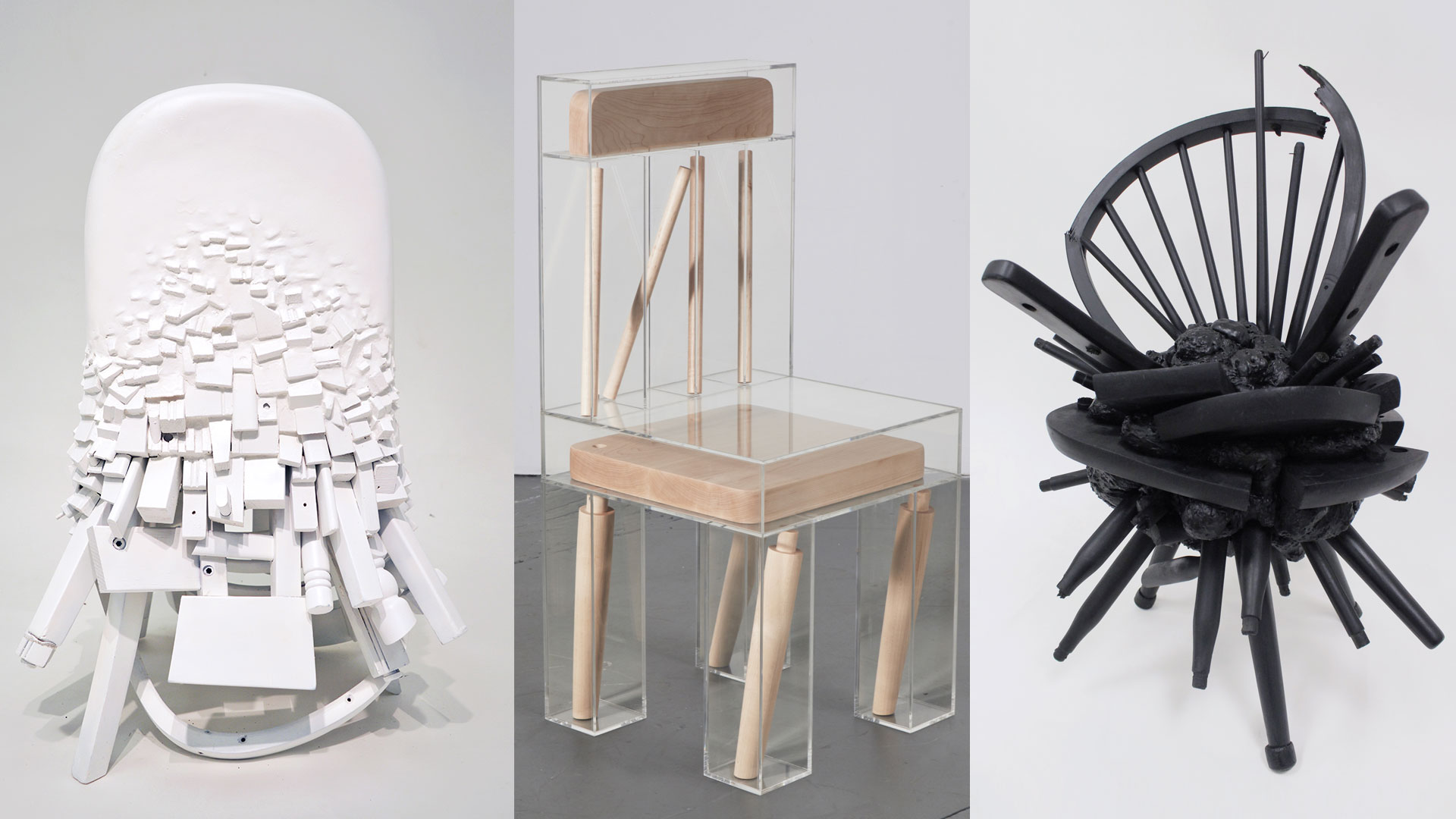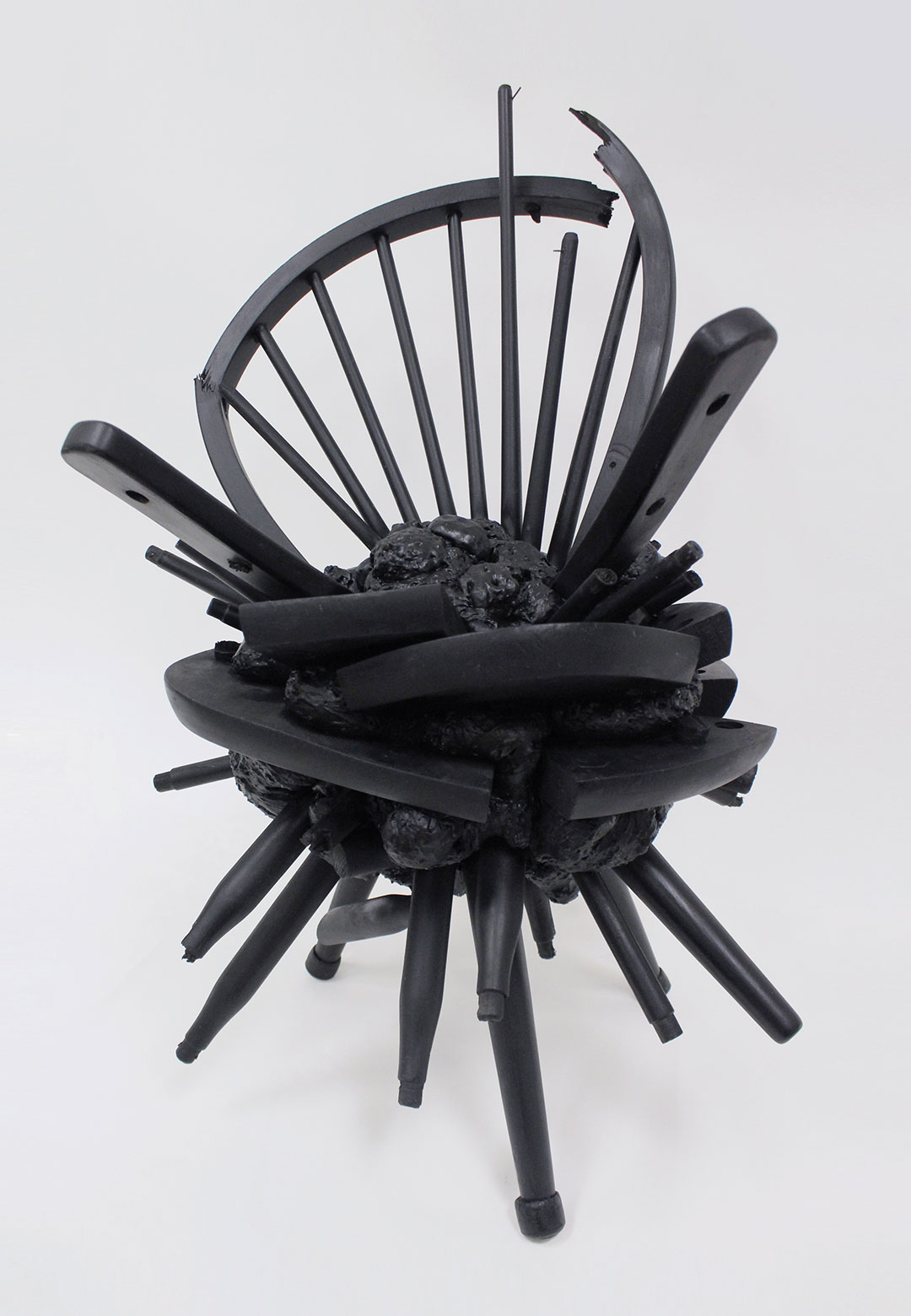Perhaps the most created, manufactured, and used product designs globally, the shapes and materiality of chairs have evolved as civilisations have progressed, from roughly-hewn hand-made stone stools to jewel-encrusted thrones of royals, or the soulless, stainless-steel benches of subway stations. Outwardly, chairs designed by Joyce Lin flout definition, their typical form, and some, even gravity, refusing to be boxed in. On a closer look, they reveal themselves as zany objects of art and sculpture, embodying arbitrarily or in fullness, their function of seating. Through her work, the American-born Taiwanese artist and product designer deconstructs and reforms furniture forms, materials, and archetypes, in her journey as a creator to explore the condition of being a maker in rapidly changing times. Take, for instance, Lin’s ‘Exploded Chair’, perhaps her most eye-catching chair design, where she takes apart the pieces that make a traditional chair, only to put them back as a disjointed whole, seemingly frozen forever in break-dance. The imperceptible ‘Negative Chair’, another unconventional seat, challenges prevalent notions of aesthetics, where an enclosed, inaccessible bubble occupies the negative space around a chair.
“I have always been fascinated with internal structures and mechanisms, how things are made and where they come from, how individual parts interact to make a functional whole, both through making and in the natural world,” says the furniture designer and artist based in Texas, who is consistently building a thought-provoking oeuvre that plays off people’s expectations, isolating and dissecting the very essence and widely accepted forms of furniture and the materials that make them, forever exploring the interconnectedness or disconnectedness of everything.
This bid to profile her young practice, replete with functional sculptural designs perchance echoes and reveals her own eclectic, curious, and ambiguous personality as both, a maker and human being. In this conversation with STIR, Lin uncovers her fascination with the iconic form of a chair, and how they are much more than just objects, how furniture design represents reality to her and how in her creative endeavours, she seeks to manipulate, question, explore, unearth, and alter that reality.
STIR: What are chairs to you, besides being an enthusiastic creator of some eccentric, creative ones?
Joyce Lin: Chairs are icons for recording changes in design values and technology throughout history. They are highly anthropomorphic objects on a human-like scale —having a back, seat, and legs —a form so iconic yet familiar, people easily relate to them. In my work, I use them as a conceptual scaffold for my ideas about material and process. In my personal life, however, I am not a big fan of chairs and would rather sit on the floor.
STIR: Tell us a bit about yourself and your journey as a creator.
Joyce: I was born in 1994 and grew up in Birmingham, Alabama. I have wanted to be an artist for as long as I can remember, but it wasn’t until much later that I started making things that could be considered objects of design. I attended a fine arts high school where I made kinetic sculptures and got hooked on making three-dimensional, interactive work. I then attended the Rhode Island School of Design and Brown University where I received dual degrees in Furniture Design and Geology-Biology through the Brown/RISD Dual Degree Program. In 2018, I relocated to Houston, Texas in the US and officially started my studio practice. I did an artist residency at the Houston Center for Contemporary Craft and exhibited and worked with various institutions and galleries including R & Company in New York City and the New Orleans Museum of Art. I also currently teaching and managing a wood shop at a non-profit maker space called TXRX Labs.
I have always been fascinated with internal structures and mechanisms, how things are made and where they come from, and how individual parts interact to make a functional whole, both through making and in the natural world. We and everything in our environment are inextricably linked in cycles of cause and effect that have persisted and evolved for billions of years. However, with increasing awareness of this human-dominated age called the ‘Anthropocene’, my wonderment about the world has begun to merge with a feeling of anxiety. I am both disturbed and captivated by the opaqueness of industrialised society, where modes of production and disposal are obscured to the public and the impacts of supposedly disposable materials like plastic, foam, and resins last far beyond time scales that we as humans can fathom.
My work is driven by this paradox of permanence and impermanence, opaqueness and transparency, that marks our contemporary materials, processes, and attitudes. As a maker, I naturally take on the role of this overwhelming human force—destroying and reforming furniture objects, combining old and new materials, and cutting them open to expose the inner workings. In my work, I want to express curiosity and mystery about the changes occurring around us. At the same time, I want the inner structures to be known and understood.
STIR: What informs your creative process?
Joyce: That’s hard to define because every project is so magically different. Like most creators, I start with sketches and work through several configurations of an idea until I acquire enough drive and curiosity to pursue it. Sometimes, I tend to mull over the same idea for months before something clicks, or feels right, where there is synergy between the concept, material, and form, as well as a learning objective in developing a new process or medium. From there, I do whatever it takes to realise that core idea, feeling, or question about objecthood, whether it be slicing apart an antique table, learning how to paint with oil paints, or trespassing on government property to collect some driftwood. Everything I make becomes a sort of tribute to my love for making.
STIR: How does being a graduate in furniture design, geology, and biology seep into your work as a designer? Do the unrelated fields inform each other from time to time in your works, and how?
Joyce: I get this question a lot (laughs). I do not necessarily think of them as being related or unrelated. All my studies feed into a fundamental interest in how things are made, how things are destroyed, the interconnectedness or disconnectedness of everything, and what it means to be a maker in the Anthropocene. Geology (and the co-evolution of the biosphere) tells us a 4.5 billion-year-long story of ourselves, and where our world comes from. It puts into perspective how bizarre modern humans and our built environments really are. It makes me think about what I want to communicate through my objects, which often involves deconstructing something familiar and transforming it into something new. Things like dissections and cross-section diagrams, and these ways of seeing things beyond their surface-level appearance, never cease to inspire me.
STIR: Could you take us behind the creative influences and identities of the ‘Negative Chair’, the ‘Exploded Chair’, the ‘Fused Chair’, ‘X’ Chair and ‘Ghostwood’?
Joyce: The ‘Exploded’, ‘Fused’, and ‘Negative Chair’ were first made as part of my senior thesis at RISD. The ‘Negative Chair’ was my first exploration into feelings of disconnection with design and the whole reality of the making process. It is a ‘bubble’ made of sections of vacuum-formed PETG sheets delineating the negative space around a chair, conceived like a sort of an ‘anti-chair’. I was inspired by the ubiquitous plastic ‘Monobloc’ lawn chair at the time and the opaqueness of manufacturing processes. The ‘Exploded Chair’ also delved into disconnection, but in a much more tangible and literal sense. An object suspended in a state where it’s neither together nor apart, never fixed in a certain position. Somehow, it has become my most well-known chair, with people sharing it on the internet. One edition of this chair design is now permanently installed in the Houston Hobby Airport and another was acquired by the RISD Museum in Providence.
The ‘Fused Chair’ is about erasure. I painted five wooden dining chairs in ghostly white, chopped them into smaller and even smaller fragments, and then re-formed them into a smooth seating surface. This gesture of something being formed from the ground up has since been repeated in other projects, such as ‘Ghostwood’ and ‘Home Grown’. This piece represents a transformation —a gradient from distinct parts to an unrecognisable matrix to a homogeneous soup. In contrast, the ‘X’ Chair in foam, part of my found furniture creations, is a project exploring pure destruction and release from structure, where parts from a single chair collapse into the centre of a bubbling black mass.
‘Ghostwood’ is a recent commission that I did for the New Orleans Museum of Art. I was inspired by Louisiana/the coastal South, natural disasters, and ‘ghost forests’ aka the watery remains of woodlands poisoned by encroaching seawater. It presents an object shaped by water, desaturated by the sun, and darkened by fire in the abstracted silhouette of an early American ladder-back chair. All driftwood was sourced from the mouths of the Brazos & Mississippi river along the Gulf Coast, burned with a torch, touched up with charcoal, and sealed with Danish oil.
STIR: Your sculptural chairs also seem to exist seamlessly as objects of art and design—what are your thoughts?
Joyce: I think there is an exciting fluidity about the contemporary design world where those distinctions matter less and less. Everything can be decorative, and functionality has become relative. I genuinely love that ambiguity, and I think it can be really powerful. It leaves room for someone like me, who is more of a conceptual thinker and maker, interested in our relationship with design objects, materials, and the natural world.
STIR: How would you describe your design language and philosophy?
Joyce: It is surprisingly consistent, though it may not seem that way at first. For example, in my sketchbook, I’ll draw a blob emerging from the ground and later find that I drew the exact same blob five years ago. That blob will make its way into the preliminary sketches of several projects, like ‘Home Grown’, ‘Fused Chair’, and ‘Negative Chair’. I am often thinking of objects in terms of dualities, like opaqueness vs. transparency, structure vs. skin, things moving from one state to another, and so on. I am more attracted to the contrasting relationships between different materials and forms and what they represent, than being attached to any one thing in particular.
STIR: What is your favourite piece of furniture that you’ve created, and why?
Joyce: My favourite is usually my most recent. I just completed a project where I made faux wood by sculpting bark out of epoxy clay and painting the tree rings. I also treasure projects where I’m not wrapped in layers of protective gear and sanding for weeks on end.
STIR: Who are your inspirations? What is NEXT for you?
Joyce: Recently, someone recommended a book to me titled All Art is Ecological by philosopher and ecologist Timothy Morton. In it, they talk about the incredible strangeness of living through an age of mass extinction, the power of art to transcend our current modes of thinking, and an expansive view of ecology that puts humans and non-humans on equal footing. I have been thinking about these things for a while – the uncanny feeling that reality is distorting in various ways, especially with the rise of digital design and fabrication, highly engineered materials, AI technology, and so on. Reality and the imagined world are merging in fascinating, sometimes scary ways. I don’t know if I would call it inspiration, but it’s certainly affecting my work, as well as the work of contemporary artists and designers around me. Currently, I am working toward my first solo exhibition with the R & Company in April, where I will be presenting a body of works that deconstruct ideas about making and materials through chair forms.






 Sign in with email
Sign in with email










What do you think?